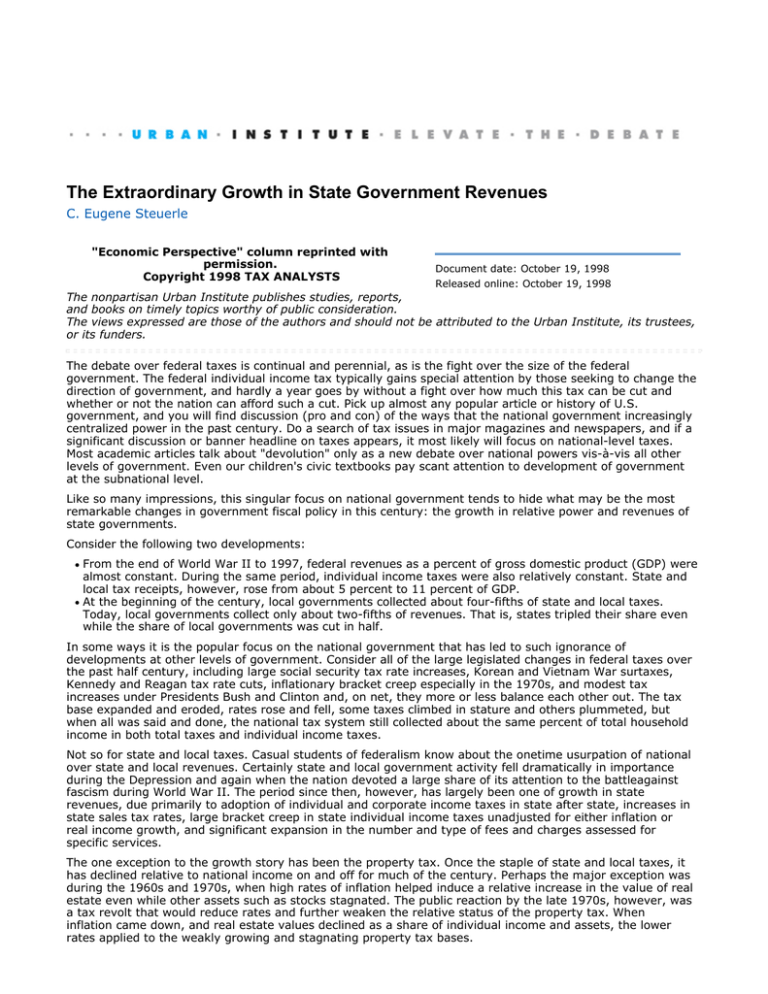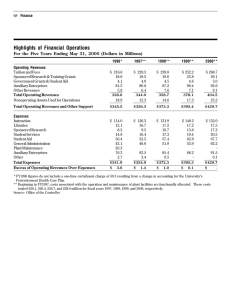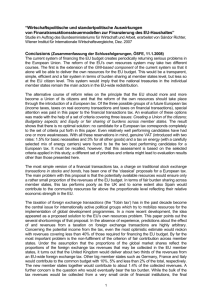The Extraordinary Growth in State Government Revenues C. Eugene Steuerle
advertisement

The Extraordinary Growth in State Government Revenues C. Eugene Steuerle "Economic Perspective" column reprinted with permission. Copyright 1998 TAX ANALYSTS Document date: October 19, 1998 Released online: October 19, 1998 The nonpartisan Urban Institute publishes studies, reports, and books on timely topics worthy of public consideration. The views expressed are those of the authors and should not be attributed to the Urban Institute, its trustees, or its funders. The debate over federal taxes is continual and perennial, as is the fight over the size of the federal government. The federal individual income tax typically gains special attention by those seeking to change the direction of government, and hardly a year goes by without a fight over how much this tax can be cut and whether or not the nation can afford such a cut. Pick up almost any popular article or history of U.S. government, and you will find discussion (pro and con) of the ways that the national government increasingly centralized power in the past century. Do a search of tax issues in major magazines and newspapers, and if a significant discussion or banner headline on taxes appears, it most likely will focus on national-level taxes. Most academic articles talk about "devolution" only as a new debate over national powers vis-à-vis all other levels of government. Even our children's civic textbooks pay scant attention to development of government at the subnational level. Like so many impressions, this singular focus on national government tends to hide what may be the most remarkable changes in government fiscal policy in this century: the growth in relative power and revenues of state governments. Consider the following two developments: From the end of World War II to 1997, federal revenues as a percent of gross domestic product (GDP) were almost constant. During the same period, individual income taxes were also relatively constant. State and local tax receipts, however, rose from about 5 percent to 11 percent of GDP. At the beginning of the century, local governments collected about four-fifths of state and local taxes. Today, local governments collect only about two-fifths of revenues. That is, states tripled their share even while the share of local governments was cut in half. In some ways it is the popular focus on the national government that has led to such ignorance of developments at other levels of government. Consider all of the large legislated changes in federal taxes over the past half century, including large social security tax rate increases, Korean and Vietnam War surtaxes, Kennedy and Reagan tax rate cuts, inflationary bracket creep especially in the 1970s, and modest tax increases under Presidents Bush and Clinton and, on net, they more or less balance each other out. The tax base expanded and eroded, rates rose and fell, some taxes climbed in stature and others plummeted, but when all was said and done, the national tax system still collected about the same percent of total household income in both total taxes and individual income taxes. Not so for state and local taxes. Casual students of federalism know about the onetime usurpation of national over state and local revenues. Certainly state and local government activity fell dramatically in importance during the Depression and again when the nation devoted a large share of its attention to the battleagainst fascism during World War II. The period since then, however, has largely been one of growth in state revenues, due primarily to adoption of individual and corporate income taxes in state after state, increases in state sales tax rates, large bracket creep in state individual income taxes unadjusted for either inflation or real income growth, and significant expansion in the number and type of fees and charges assessed for specific services. The one exception to the growth story has been the property tax. Once the staple of state and local taxes, it has declined relative to national income on and off for much of the century. Perhaps the major exception was during the 1960s and 1970s, when high rates of inflation helped induce a relative increase in the value of real estate even while other assets such as stocks stagnated. The public reaction by the late 1970s, however, was a tax revolt that would reduce rates and further weaken the relative status of the property tax. When inflation came down, and real estate values declined as a share of individual income and assets, the lower rates applied to the weakly growing and stagnating property tax bases. Real estate, especially land, is considered an immobile factor and, therefore, one that can be assessed and collected at the local level. Outside of fees for services rendered, it has remained the basic source of revenues or taxes assessed by local governments. But it hasn't been an entirely reliable source. Dissatisfaction with this revenue source has a long history -- as both a large tax and one less hidden than others, it usually alternates with the federal income tax as the most unpopular of taxes. The attack on the real estate tax does not come only from those who want smaller government. Today it is indirectly under siege by those who want greater equalization of spending for students across a state. In state after state, the response has been that financing of local schools has been taken over increasingly by state government, either through legislative initiative or court order. Whatever the reason, the net result has been the further centralization of financing at the state level. Despite this increased power over revenues at the state level, the administration of many programs, including primary and secondary public schools, still rests mainly at the local level. When states want to achieve some purpose, they often send funds to local governments or make contracts with local companies. This distinction between financing and implementation or administration is very similar to what is happening when the national government sends money to the states. The centralization of financing at the state level within the state and local universe follows patterns that have played out with national-level decisions. Financing has become more centralized partly because of the greater ease with which larger governments can collect many types of taxes without worry about taxpayers moving to another jurisdiction to escape the tax. Another driving force has been the demand for equality in the treatment of citizens across larger jurisdictional boundaries. Like all trends, large growth in state revenues as a percent of GDP and centralization of state and local financing at the state level need not and mathematically cannot continue forever. Whatever else these remarkable statistics tell us, they warn us that federalism is not just an issue of what the national government is doing. The core questions remain what they have always been: which levels of government can best collect, which can best administer or execute programs, and what are the consequences when the financing and implementation of programs are separated? Other Publications by the Authors C. Eugene Steuerle Usage and reprints: Most publications may be downloaded free of charge from the web site and may be used and copies made for research, academic, policy or other non-commercial purposes. Proper attribution is required. Posting UI research papers on other websites is permitted subject to prior approval from the Urban Institute—contact publicaffairs@urban.org. If you are unable to access or print the PDF document please contact us or call the Publications Office at (202) 261-5687. Disclaimer: The nonpartisan Urban Institute publishes studies, reports, and books on timely topics worthy of public consideration. The views expressed are those of the authors and should not be attributed to the Urban Institute, its trustees, or its funders. Copyright of the written materials contained within the Urban Institute website is owned or controlled by the Urban Institute. Source: The Urban Institute, © 2012 | http://www.urban.org



